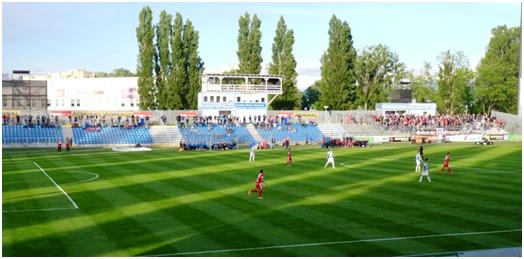Eurotour of 2014. Part 1
Needing to keep my plans flexible, I started with a Airmiles ticket from London to Frankfurt. Neither Airport is exactly easy to navigate, as shown by the fact I spent longer on the ground at each, than I did in the air between them. I wanted to book an overnight train for Wednesday, and finding the Reisezentrum meant going to one part of the airport station, but then walking back to the other section for a train into the city centre. I stayed at the Excelsior, almost adjacent to Frankfurt Hauptbahnhof. It is a convenient and not pricy hotel which includes the stock in the minibar (beer, water, orange juice) and breakfast in its price. With an early start on a train stopping in Achaffenburg, it may have been better to stop there, but I had already booked an unchangeable room before picking on the route for the morning. On a tour exceeding two weeks, one is bound to miss a train or two, but I had not expected this to happen on the first day – and it was all my fault. Sitting in the hotel room and surfing the net over later parts of the tour, I forgot the time difference between the computer clock and Germany. Hence my plan to arrive in Achaffenburg well before kick off and have a leisurely walk to the stadium were replaced by rushing straight in from the station, (still arriving 15 minutes before kick off). Achaffenburg sits close to the Hessen/Bavarian border, and in recent years its club, Viktoria had deserted Bavarian football for the lesser journeys in the more Westerly league. When the leagues were re-aligned two years ago, the club were faced with the choice of either staying where they were, in the fifth level Hessenliga, or taking a promotion which their league position did not justify to the new, fourth level, Regionalliga Bayern. There was a vote on it, and it was overwhelmingly in favour of the Bavarian option. Two seasons later, the lure of a higher league dominated by the reserve teams of the two Munich clubs does not look so bright. The option to switch back is not open, and so Aschaffenburg will be relegated to the Bayernliga Nord. Eight miles up the road, and still in Bavaria, Bayern Alzenau (also Bavarian, as the name suggests) play in the Hessenliga.
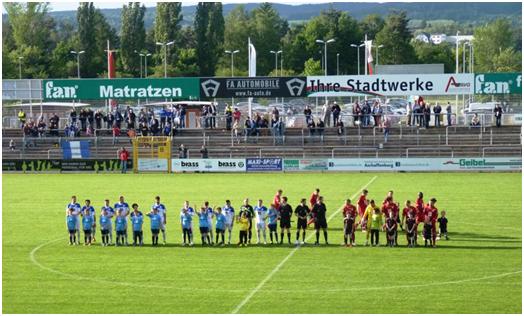
In the Regionalliga, the closest geographical rivals are Würzburger Kickers, and this is the match I am seeing. There are plenty of police in force, but the rivalry is not backed up by years of playing each other, as the teams have been in different regions until the last two seasons. Anyway, it is hard to create animosity when crowds go below 500. The Stadion am Schönbusch is just across the river Main from centre of the city. It has concrete stepped terracing (no cover) along one side and behind the town end goal, (where the away fans are penned in). This probably once curved around to the South side, but has been replaced by the main stand. A large construction held up by a mesh of steelwork. It does not look as if it has been sitting there for all the 25 years since Viktoria’s short stay in the 2.Bundesliga – but it has stood for many years, and is clearly meant as a permanent structure. Two more, older stands sit behind the goal at the Western end of the ground with the players entering and leaving the pitch from between these. From the terracing, one has to stand at the top to see over the fences that still blight most of Germany’s grounds, so I elected to pay the extra €4 for the tribune. The seats behind the goal are at the same cost €8 as the terracing. The A4 sized programme is free and handed over with the tickets. For the team sheets, a simple request suffices. The 6.30 kick-off is proscribed by the lack of floodlighting at the ground.
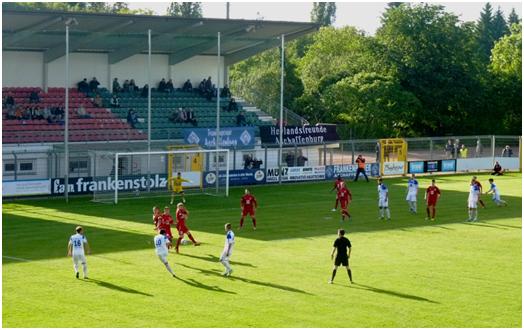
Technically, Viktoria Aschaffenburg were not relegated before the days starts, should they win three games, while Bayern Hof get no more than one point, and … loses all three, then they would get into the play offs. There is a lack of belief in this possibility, both on and off the pitch. Kickers have the best of the early attacks, and in particular they are strong on the right side. In the sixteenth minute, a low dive from around the edge of the area finds the target and Würzburg have the lead. Job done, the game immediately becomes comatose, and nothing of note happens up to the half time interval. At half time, Viktoria shuffle the side, switching from 4-4-2 to 4-2-3-1 and moving their small Japanese player (whose hair has an unnerving appearance of moving independently from his head and getting worrying close to reaching a resonant frequency in it oscillations) to the centre of the field. Nagakawa had been the only player in the first period who showed any flair, and by moving position he did not see the ball for nearly 30 minutes. Midway through the second half, and almost out of the blue, Guilio Fiordelisi finds space on the left wing and sweeps in an equaliser. Suddenly the game comes to life as both sides decide to enter a competition for missing the target from the best position. Naturally even here Würzburg lead the way, missing twice as many easy chances as the home side, but then as the clocks tick over to injury time Ricardo Borba messes up and actually scores the winning goal from just inside the left corner of the penalty box.
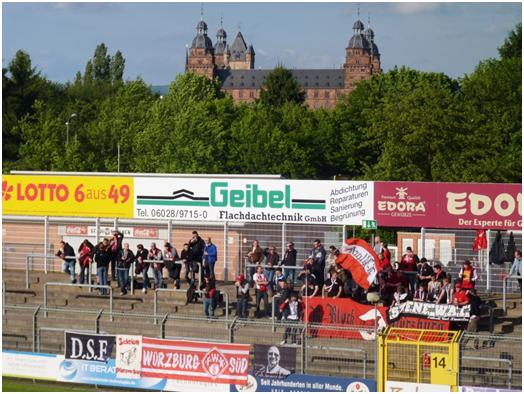
With 90 minutes before my train out, I take my leisurely stroll through the town. There is a pleasant old town, well preserved and kept apart from the modern shopping zone. Meanwhile from any direction, including the football ground, the view is dominated by the large red block of the Schloss Johannisburg, sitting in a prime position above the River Main.
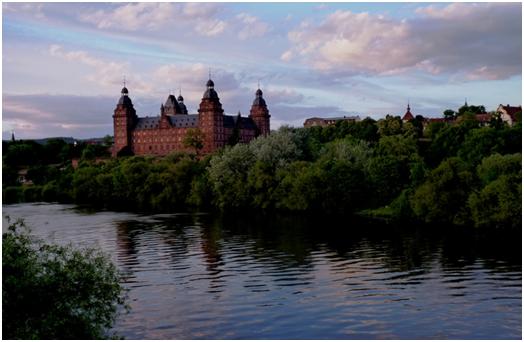
The plan for this trip is to sleep in hotels whenever possible, and then travel early in the day, and Saturday involves a typical journey, leaving the hotel in time for the 07.30 off Frankfurt, heading for Salzburg with a change at Munich. The ICE provides a comfortable platform for sitting and writing up my notes so far. The train is busy but not full and I get a pair of seats without having to search. There are a few police and some Eintracht fans around, but they are not heading into Bavaria. Football support in Germany tends to be more regionalised than in England, but Bayern Munich does take support from all over Bavaria, and there are plenty of red scarves and shirts in the train, even though it arrives in the city at 11.00, four and a half hours before kick off. Then I know some Cheltenham fans who would consider this to be a shortened day as far as drinking time is concerned.
Getting on the S-bahn at Salzburg, things are so quiet I almost think I am in the wrong place – then I spot about half a dozen fans bedecked in Violet colours, and carrying a crate of beer. Well, it is 12 minutes, and they would not want to get thirsty, would they? Directions from the station to the ground. One of the visiting fans asked a local at the station – he pointed upwards. This is accurate! I took a slightly longer route, to check on the village. It is small, not very interesting and very closed. The name, Seekirchen suggests a lake side church, but it appears the lake is some distance away. The ground is the Sportplatz, and has three football pitches, with a double sided stand positioned between two of them. There are a number of clay tennis courts, and two beach volleyball courts, as well as a sprinting track. No cricket square though. Taking advantage of being at the top of the hill, the clubhouse has been built well above the pitch level, a two storey building with the dressing rooms upstairs. There is a balcony upstairs, a terrace below (lots of seating and table for your beer), and a terrace half way down (the level with the track). A lot of people were watching from these vantage positions, which is just as well as the rest of the ground is one sided, with the stand and the top of the grass banking each side of the stand. Surprisingly there is no barriers marking off the pitch, some temporary fencing was added in front of the stand while the rest of the pitch is marked off with tape. Looking back at the records, the crowd was 350 for their last game. In England, a club like this would really need to do a lot of work before being in a league with 350 people present. For the visit of league leaders Austria Salzburg, the official crowd figure was 1200. I would have guessed more. Admission was €10, no programme was available, but beer was. Austria Salzburg was formed by fans after the original club of the same name (founded 1933) was renamed Red Bull and changed colours. Not surprisingly, they have a close affinity with AFC Wimbledon and FC United. They started in 2006/7 in the seventh level of Austrian football – they won league titles and promotion in each of their first four seasons, but the Regionalliga has been more difficult and this is their third season at level 3. Just to rub salt into the wound, Red Bull’s nursery club, Liefering won promotion last season and now share the Red Bull Salzburg stadium. This season, Austria Salzburg have gone through unbeaten with 22 wins and four draws before I arrived in Seekirchen. Still with second placed Wattens winning the night before, they cannot take the title in this game, as a win would leave them nine points ahead, three to play.
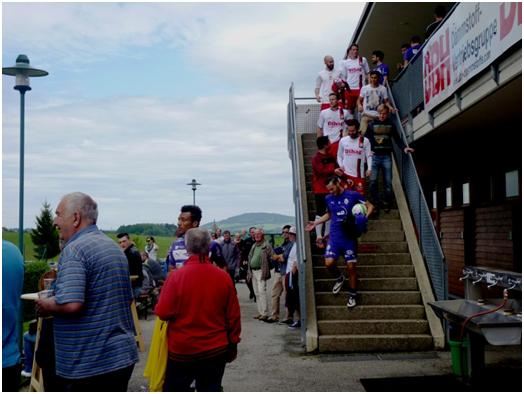
After a quick check to make sure no English Ground Grader is watching, the teams leave the dressing rooms (Seekirchen in White)
The first half of the game was played at a slow pace, which just occasional touches from either side to convince us a game was in progress. Not surprisingly, Austria Salzburg had most of the good chances, with two poor misses and two good saves from the lengthily named Matthew O’Connell-Harold, (not very Germanic, I thought). The best chance comes in the last minute, when Seekirchen send the ball across the face of the goal just inviting a touch that never comes. It would be more than 30 minutes of game time later before Seekirchen get the ball into their opponents penalty area again. In the second period, Salzburg just camp out in the opposition half. It looks like it is just a matter of time before the home defence is breached. Sometimes appearances are deceptive. This was not one of those times. On 63 minutes, Marko Vujic is given too much space on the edge of the area – his shot goes in to the top corner. The second comes from a free kick on 73 minutes, Rajic the scorer, while Onisiwo delicately flicks the ball over O’Connell-Harold with three minutes left on the clock.
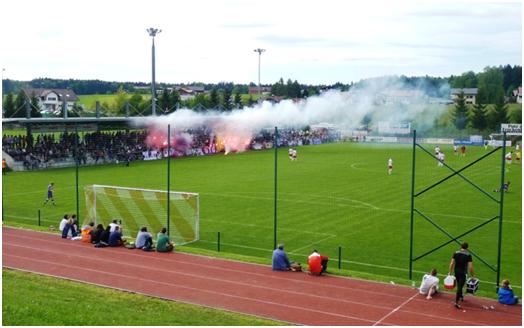
Salzburg fans greet their team before the start of the second half#
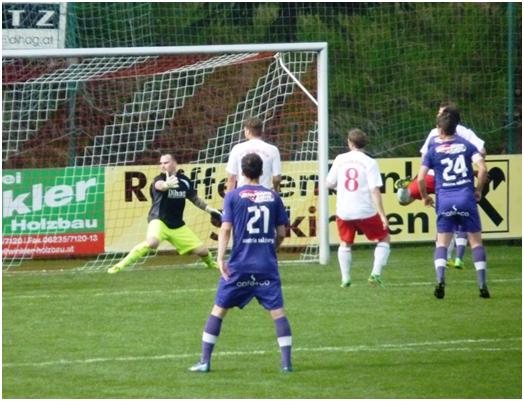
Ball watching – none of the players in the picture can get to touch the ball as it moves through the cameras line of sight for the second goal.
I expected the visiting fans to invade the pitch at the whistle, but they all stayed their ground. None rushed back to the train though and I think I was the only spectator to the station for the first train, 20 minutes after the whistle.
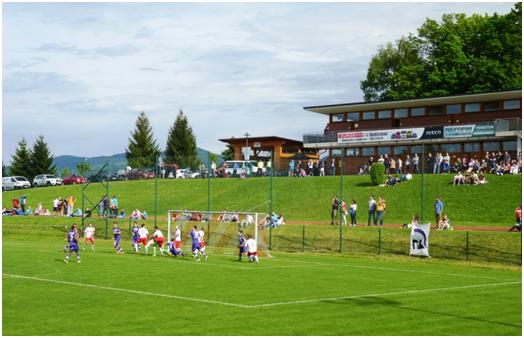
Two years ago, I had chosen Stadlau over Donaufeld as my Sunday morning game before seeing the Austrian Cup Final. The main reason for this was that it was starting a little later, and was easier to get to from where I was staying, so I could have an extra half hour in bed. Donaufeld did not feel put out by the news and have stuck to Sunday morning kick offs at 10.15. The opposition was Stadlau, so I did not have the choice this time. First against second in the Wiener Stadtliga, one of the nine divisions at level four in Austria. The league runs on to Mid June and there are six games including mine to play, but with a 12 point gap between Donaufeld and the visitors, there was little chance of this being a crucial fixture.
The ground is relatively easy to get to, a 15 minute walk from Florisdorf station, or two tram stops and a two minute stroll. Even though my U-Bahn ticket was valid on the tram, I elected to walk there. The ground features a large and relatively modern stand along almost the entire length of one side. Eight rows of bench seats and a small announcers’ box where they were happy to let me view the team sheets. (€7 to enter, no programme). There were a couple of stalls selling food, drink and tombola tickets by the entrance and a small bar/clubhouse with a lot of photos of the team. It is notable that the have clearly one the Stadtliga several times in the past, but there is no mention of any honour at higher or lower levels! There is a second pitch behind the main stand, but this has now been fenced into two mini pitches. As a sports club, it also offers a couple of clay tennis courts.
It started to rain just as I arrived, and rained (often heavily) throughout, so I only ventured away from the stand to buy half time refreshment. A few people stood under unmbrellas in this area, but no one watched from the other sides. There was no access in front of the monolithic dressing rooms at one end, and I did not investigate whether one could access the far end through the stand (and then walk on to the far side). The game was not a classic, but was also not dull. Neckam made several fine sides to keep Donaufeld at bay, but the best chance fell and was missed by his teammate, Philip Wendl. A long distance shot was parried by the home keeper and the loose ball fell to Wendl with an open goal in front of him. Somehow he mis-kicked and it went high and wide. Stadlau’s chances were not helped when Wendl’s strike partner, Arben Selami received a second yellow card in the 56th minute, and the team were reduced to playing 4-4-1. Still they did enough to keep out the home side for home the eventual 0-0 draw will not be seen as a hindrance to their title ambitions.
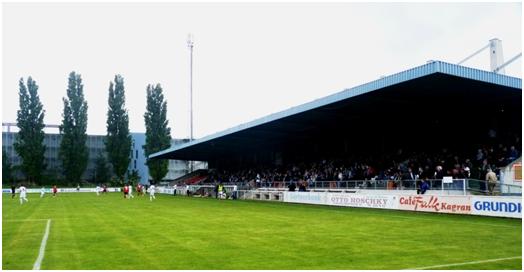
With the rain now quite heavy, and despite the fact my local transport ticket had timed out (and the nearest place to buy a new one was at the station), I took the tram back to Florisdorf. From there on to Wiener Neustadt, unconcerned by the increasing rain until I had to contend with the half hour walk with nothing except a damaged umbrella for company. When one reaches the main road, the cars do not slow down or avoid the surface water hence splashing any suspecting pedestrian, (well me actually, no one else was walking this way). It was very early, so I was unconcerned that there was no one around, and at least I had the matchday parking restriction signs to confirm I was heading to the right place. SO it was only on arriving that it actually dawned on me why there was no activity. The gates were open and the ticket sellers booths were closed, with just a sign to say, Abgesaft. While I did not need a translator, I did enter, hoping to find a chance to dry a little before heading back. The clubhouse was closed, but I found my way to the offices which were staffed. They confirmed (in English of course), that the game was off, and that it had been re-arranged for the next day. They even called a taxi to stop me having to walk back to station
SO I was left with a quandary –should I return to Wiener Neustadt the next day and hope the weather did not intervene again, or should I stick to the original plan- a fifth level game in Germany. With the travel options out of the German game being poor, a late night train with seats only, while Neustadt offered a hotel and a connection starting at 10.30 in the morning, a phone call to the club early in the morning made up my mind. The pitch had recovered and unless there was (unforecasted) heavy rain, the game would be on.
It turned out to be a good decision to stay in Austria for the held over final game of the season
Wiener Neustadt translates as Vienna Newtown, and could fill the unwary traveller with fear based on the dull new towns in England, but of course, once the name Neustadt is given, it remains even though the town grows old. The town actually dates back to 1191, possibly the oldest “New Town” in Europe. It was built up with funds procured by capturing (as they called kidnapping in the 13th century) the King of England (aka Richard I), and ransoming him. Little, if any of the town is that old, but its 18th/19th century heritage makes it a more than pleasant (if rather quiet) place to visit.
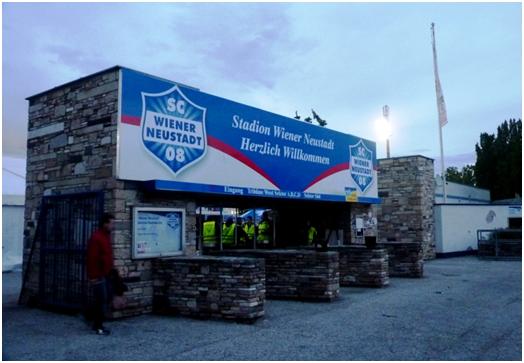
The unimaginatively named Stadion Wiener Neustadt (wot, can’t find a sponsor?) once had a track, but this had been covered by artificial grass. The main field is grass, (which was waterlogged 26 hours earlier), and slopes gently down at one end, the slope is not consistent and I think the worse puddles were actually near the top end. There is a long stand on one side, 8 rows of seats with a wide path at the top. They charge €15 to stand on the pathway, and €20 for a seat. They do not put in stewards to sort out who has the seating tickets. At the back of the pathway are food and drinks outlets and they have thoughtfully bolted a flat surface to the barrier between the standing and seats (with a slight wall as well), so you have a surface for your beer glass, (well beer plastic), and if you do knock it, it does not have to go all over someone sitting in the back row.
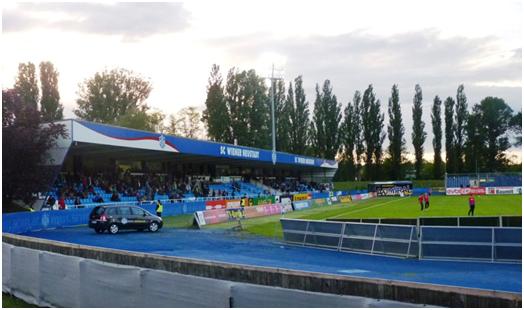
The track was once surrounded in part with a grass bank, but much of this opposite the main stand has been concreted with seats put down, and a further seatng stand (the scaffolding type) had been placed square behind the bottom goal, mainly inside what remains of the track. All these seats are uncovered. One section of the side opposite the stand has been left as concrete steps, and fenced off for away fans. Only a small portionof the home fans chose the uncovered areas.
And so, the battle for 8th place in a league of ten teams in which only one (Wacker Innsbruck) gets relegated. The match was billed as a local derby, although the two Vienna teams (Rapid and Austria) are far closer to Admira Wacker Modling’s Sudstadt Stadion. They do play in Niederostereich (Lower Austria), and not Wien itself, so there is some excuse for inventing rivalry. The game was a contrast of styles, the visitors were determined to pass their way through the home defence, while the home team were more in favour of fast moves, and route one.
I made Markus Glanzer, the Neustadt goalkeeper man of the match. He made two critical saves at 0-0 and then got the assist for the opening goal. His long kick bounced twice, bamboozling a rather slow defender and allowing Thomas Froschl to lob the ball over the Wacker keeper. Wacker almost got back on terms, with a header against the bar from a corner, but Neustadt’s next corner was better, headed on to Froschl to score again.

In the 42nd minute, Wacker should have pulled one back. Glanzer pulled back Rene Schicker as the midfielder tried to run around him. It looked foolish as the player was moving too fast and was unlikely to have been able to control the ball. Even if he had it would have been a difficult angle. Fortunately, the referee agreed with my thoughts and only gave a yellow card. Glanzer did not get anywhere near Stefan Schwab’s chipped penalty. Not many players try a chipped penalty – although it is guaranteed to go over a diving keeper, one that stands his ground has a good chance. The other thing, as we saw is what goes up comes down at its own pace – in this case bouncing off the bar for a goal kick!
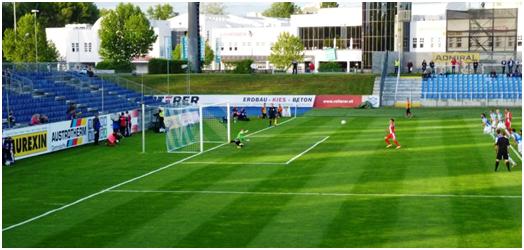
The wrong way to take a penalty
I still fancied the game had life. I just though Wacker were too good to be 2-0 down. Two corners early in the second half proved my point – 2-2!
Between these, Frschl missed a chance to complete his hat-trick, and if a dangerous free kick from the right had found a head, then Wacker may have been 3-2 up. Instead, their defence parted again, the ball again fround Froschl and this time he did complete his hat-trick. Another excellent save from Glanzer kept the lead for Neustadt and Froschl now turned provider, crossing for subsitute Pichlmann to make it 4-2 in the 80th minute. Pichlmann then added the final goal with three minutes to play, and the season which had gone on 26 hours longer than intended was brought to a close.
